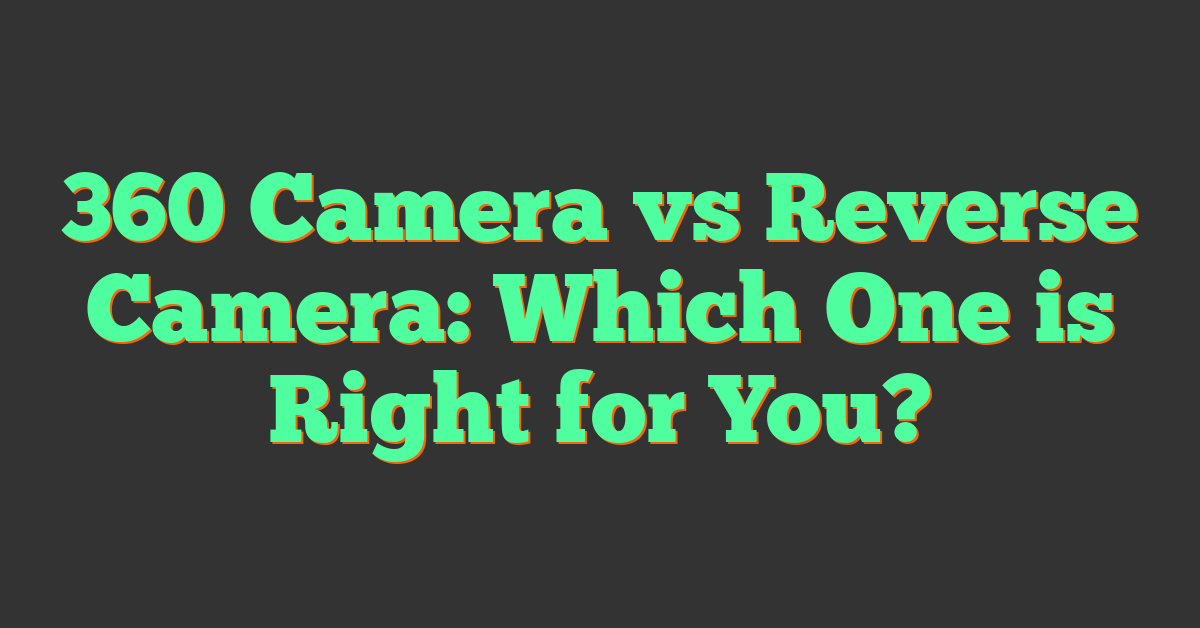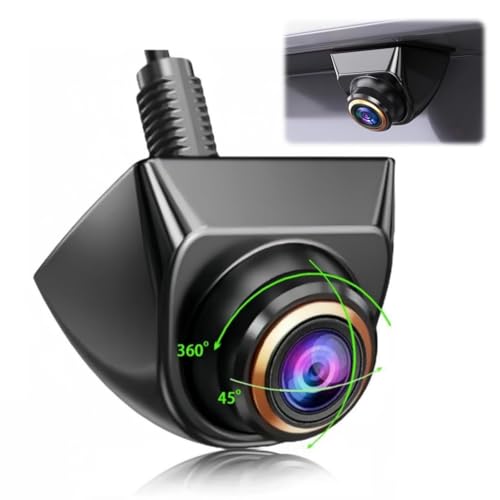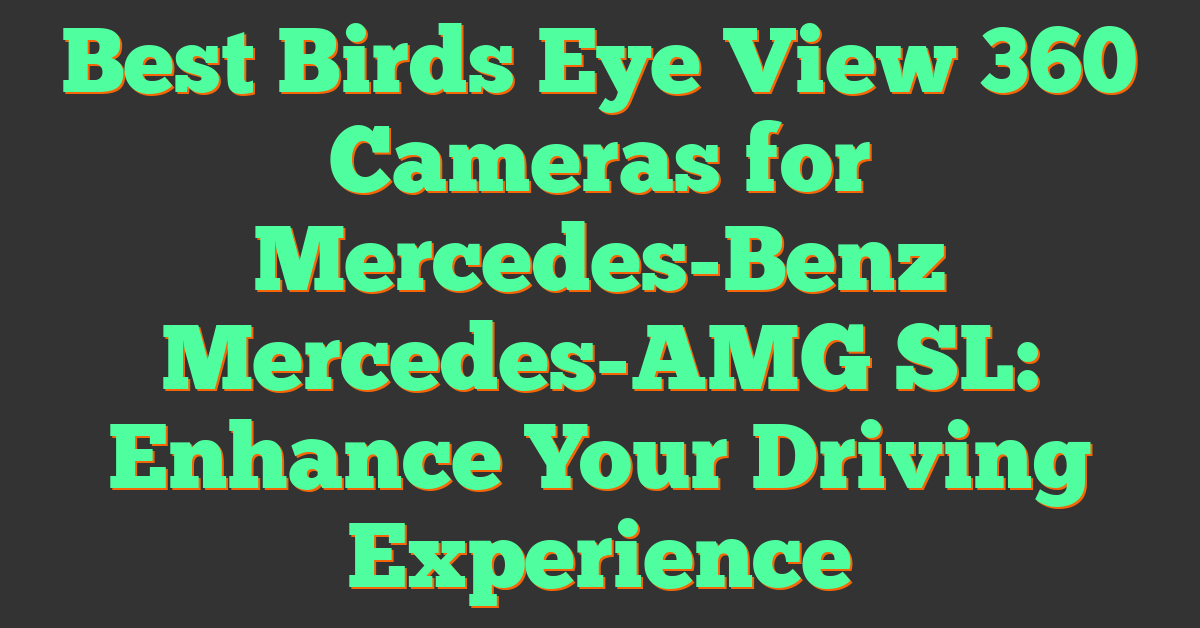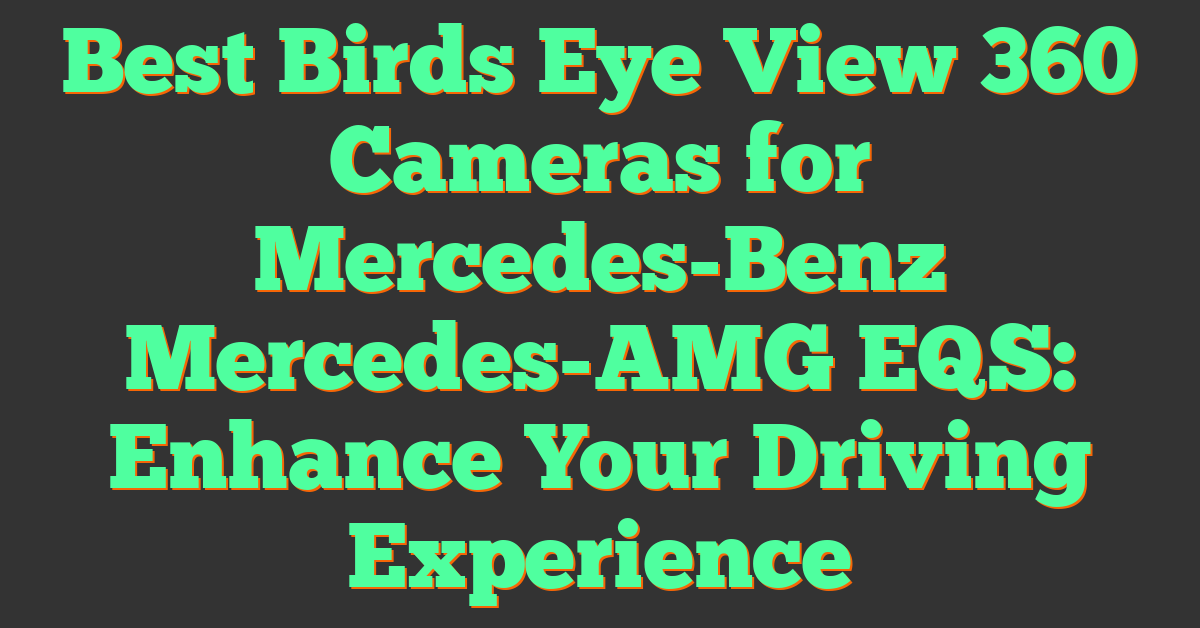If you’re in the market for a camera, you might be wondering whether you should get a 360 camera or a reverse camera. Both types of cameras have their own unique benefits and drawbacks, and choosing the right one depends on your specific needs and preferences. In this article, we’ll explore the differences between 360 cameras and reverse cameras, and help you make an informed decision.
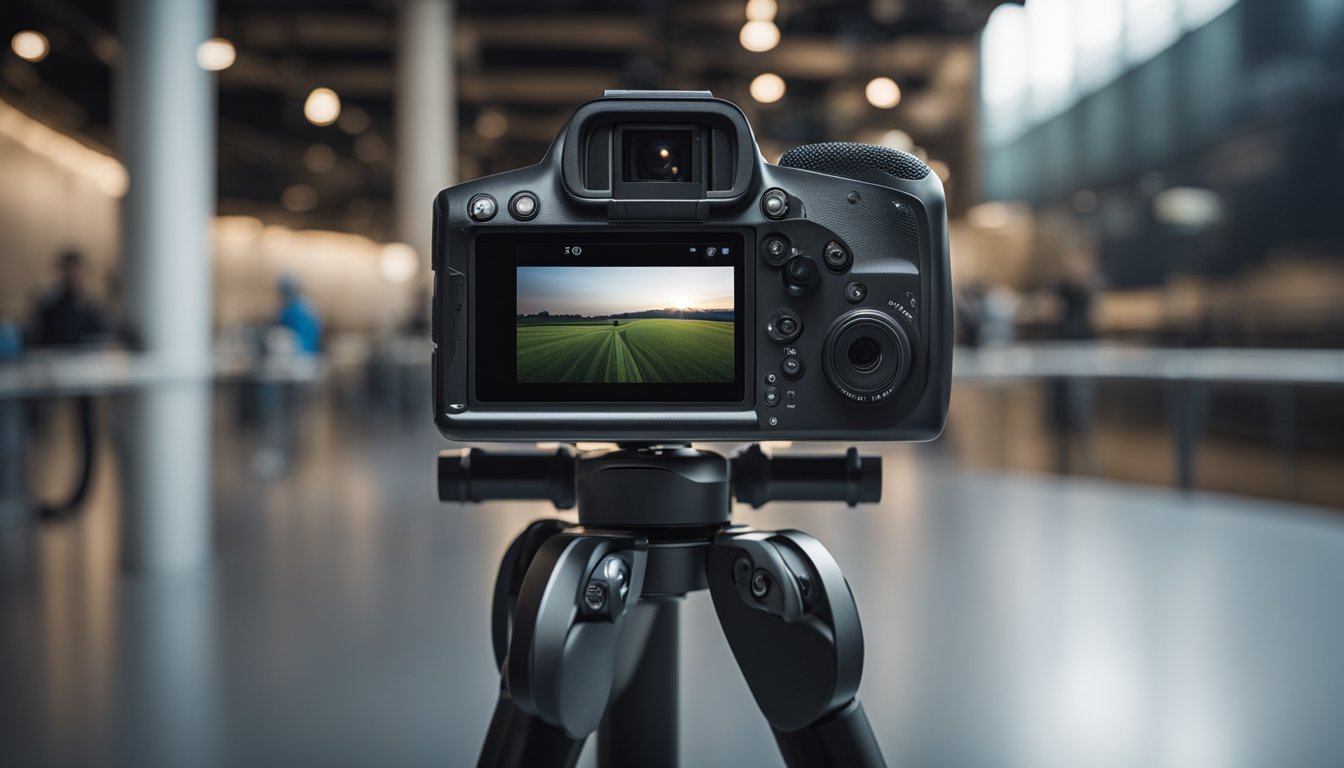
Understanding 360 Cameras
360 cameras are designed to capture a full 360-degree view of your surroundings. They use multiple lenses to capture images from every angle, and then stitch them together to create a seamless panoramic image or video. This makes them ideal for capturing immersive experiences, such as virtual tours, travel videos, or action sports footage.
Exploring Reverse Cameras
Reverse cameras, on the other hand, are designed to help drivers see what’s behind them when they’re backing up. They’re typically mounted on the back of the car, and provide a wide-angle view of the area behind the car. This makes them useful for avoiding collisions with other cars, pedestrians, or objects when backing up. Some reverse cameras also come with sensors that beep or flash when you get too close to an obstacle.
Key Takeaways
- 360 cameras are ideal for capturing immersive experiences, while reverse cameras are designed to help drivers see what’s behind them when backing up.
- 360 cameras offer better video and image quality, while reverse cameras are more affordable and easier to install.
- When choosing between a 360 camera and a reverse camera, consider your specific needs and preferences, as well as the cost, ease of use, and durability of each type of camera.
Understanding 360 Cameras
https://www.youtube.com/watch?v=xqWkJJOcU4g&embed=true
Evolution of 360 Cameras
360 cameras have come a long way since their inception. Initially, they were bulky and expensive, and only professionals could afford them. However, with time, they have become smaller, more affordable, and easier to use. Nowadays, 360-degree cameras are available in different shapes and sizes, and they can be used to capture photos and videos for personal and professional use.
How 360 Cameras Work
360-degree cameras are designed to capture a scene from all angles, creating an immersive experience for the viewer. They use multiple lenses to capture the image, and then software stitches the images together to create a seamless 360-degree view. The software can also be used to edit the images, add filters, and adjust the exposure.
When it comes to video, 360-degree cameras work by capturing footage from all angles simultaneously. The footage is then stitched together to create a seamless video that can be viewed in 360 degrees. Some 360-degree cameras also have the ability to capture sound in 360 degrees, which adds to the immersive experience.
One of the most significant advantages of 360-degree cameras is their ability to create immersive experiences for virtual reality (VR) applications. 360-degree cameras can capture footage that can be viewed in VR, allowing viewers to feel like they are actually in the scene.
In conclusion, 360-degree cameras are a great tool for capturing immersive photos and videos. They have come a long way since their inception, and they are now more affordable and easier to use than ever before. With their ability to capture immersive footage for VR applications, 360-degree cameras are becoming increasingly popular in both personal and professional settings.
Exploring Reverse Cameras
https://www.youtube.com/watch?v=oIN8qRcH_8M&embed=true
If you’re looking for a safer and more convenient way to park your car, a reverse camera might be the solution you need. Also known as backup cameras, these devices are mounted on the back of your vehicle and provide a clear view of what’s behind you when you’re reversing. Here are some of the basics of reverse cameras and how they integrate with your vehicle’s systems.
The Basics of Reverse Cameras
Reverse cameras work by capturing video footage of the area behind your vehicle and displaying it on a screen inside the car. This allows you to see obstacles, pedestrians, or other vehicles that might be in your way as you back up. This is especially useful in tight parking spaces or when you’re reversing out of a driveway onto a busy street.
« Why Is Camera 360 So Popular Among Photographers?
Cheap 360 Camera for Sale: Capture Your Memories on a Budget »
Most reverse cameras have a wide-angle lens that provides a broad view of the area behind your car. Some also have distance lines that help you judge how far away objects are from your vehicle. This can be especially helpful when you’re backing up to a wall or another vehicle.
Integration with Vehicle Systems
Many newer vehicles come with reverse cameras built-in, but you can also purchase aftermarket cameras that can be installed on older cars. Some reverse cameras are integrated with other vehicle systems, such as blind-spot monitoring or parking sensors. This can provide a more comprehensive view of your surroundings and make parking even easier.
Reverse cameras can also be integrated with your car’s infotainment system, allowing you to control the camera and view footage on the same screen you use for music, navigation, and other functions. This makes it easy to switch between camera views and keep an eye on what’s going on behind you.
Overall, reverse cameras are a great way to improve your safety and convenience when parking your car. They provide a clear view of what’s behind you, making it easier to avoid accidents and park in tight spaces. If you’re looking for a way to upgrade your vehicle’s functionality and safety, a reverse camera is definitely worth considering.
Comparing Video and Image Quality
https://www.youtube.com/watch?v=kelEKmgsauw&embed=true
When it comes to 360 cameras and reverse cameras, one of the most important factors to consider is video and image quality. Here, we will compare the quality of the two types of cameras.
Resolution and Detail
In terms of resolution and detail, 360 cameras have the upper hand. They can capture images and videos in a full 360-degree view, which means that they can capture more detail than reverse cameras. Most 360 cameras can capture images and videos in 4K resolution or higher, which means that the images and videos are very sharp and detailed. On the other hand, reverse cameras usually capture images and videos in lower resolutions, which means that the images and videos are not as sharp and detailed as those captured by 360 cameras.
Dynamic Range and Low Light Performance
When it comes to dynamic range and low light performance, reverse cameras have the upper hand. Reverse cameras are designed to work in a variety of lighting conditions, which means that they can capture images and videos in low light conditions. On the other hand, 360 cameras can struggle in low light conditions, which means that the images and videos captured by 360 cameras can be grainy and blurry.
In terms of dynamic range, reverse cameras are also better than 360 cameras. Reverse cameras can capture images and videos with a wide dynamic range, which means that they can capture both bright and dark areas in the same image or video. On the other hand, 360 cameras can struggle with dynamic range, which means that the images and videos captured by 360 cameras can be overexposed or underexposed.
Overall, when it comes to video and image quality, 360 cameras are better in terms of resolution and detail, while reverse cameras are better in terms of dynamic range and low light performance.
Analyzing Cost and Value

Price Points
When it comes to comparing 360 cameras and reverse cameras, the first thing you will notice is the price difference. 360 cameras are generally more expensive than reverse cameras, with prices ranging from $200 to $1,000 or more. On the other hand, reverse cameras are relatively inexpensive, with prices ranging from $20 to $200.
Cost-Benefit Analysis
The cost-benefit analysis of 360 cameras and reverse cameras depends on your individual needs and preferences. If you are a professional photographer or videographer, a 360 camera may be worth the investment as it allows you to capture immersive 360-degree content. However, if you only need a camera for basic functions like parking assistance, a reverse camera may be the better option.
In terms of value, 360 cameras offer a unique and immersive experience that cannot be replicated by reverse cameras. With a 360 camera, you can capture an entire scene in one shot and explore it in a more immersive way. On the other hand, reverse cameras offer a more practical benefit by helping you park and navigate tight spaces.
Overall, the cost and value of 360 cameras and reverse cameras depend on your individual needs and preferences. If you are looking for a camera that offers a unique and immersive experience, a 360 camera may be worth the investment. However, if you only need a camera for basic functions like parking assistance, a reverse camera may be the more cost-effective option.
Assessing Ease of Use
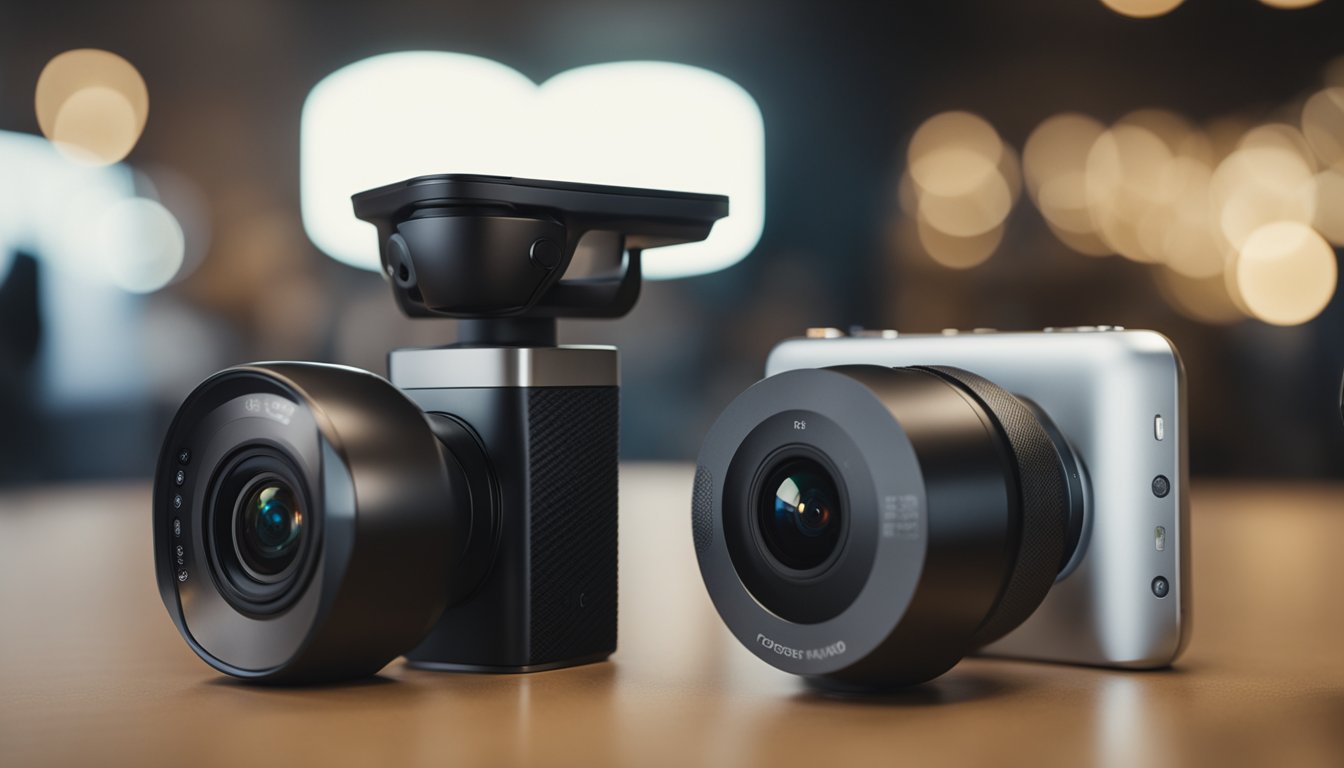
When it comes to ease of use, both 360 cameras and reverse cameras have their own pros and cons. In this section, we will take a closer look at the user-friendly features and learning curve for beginners for both types of cameras.
User-Friendly Features
360 cameras come with a range of user-friendly features that make them easy to use for beginners. For instance, many 360 cameras come with built-in stitching software that automatically stitches together the images captured by the camera. This means you don’t need to learn how to use complex software to create 360-degree photos and videos.
On the other hand, reverse cameras are designed to be simple and easy to use. They typically provide a clear view of what’s behind your vehicle, making it easier to reverse without hitting anything. However, they lack the advanced features of 360 cameras, such as the ability to capture a full 360-degree view.
Learning Curve for Beginners
360 cameras can be more challenging for beginners to use, as they require a bit of practice to get the hang of. You need to learn how to position the camera correctly to capture a full 360-degree view, as well as how to use the stitching software to create seamless photos and videos.
Reverse cameras, on the other hand, are much easier to use. Most drivers can simply install the camera and start using it right away. However, it’s important to note that reverse cameras don’t provide a full 360-degree view, so they may not be as useful in certain situations.
Overall, when it comes to ease of use, both 360 cameras and reverse cameras have their own strengths and weaknesses. 360 cameras offer more advanced features, but require a bit more practice to use effectively. Reverse cameras are simpler and easier to use, but don’t provide a full 360-degree view.
Durability and Design Considerations
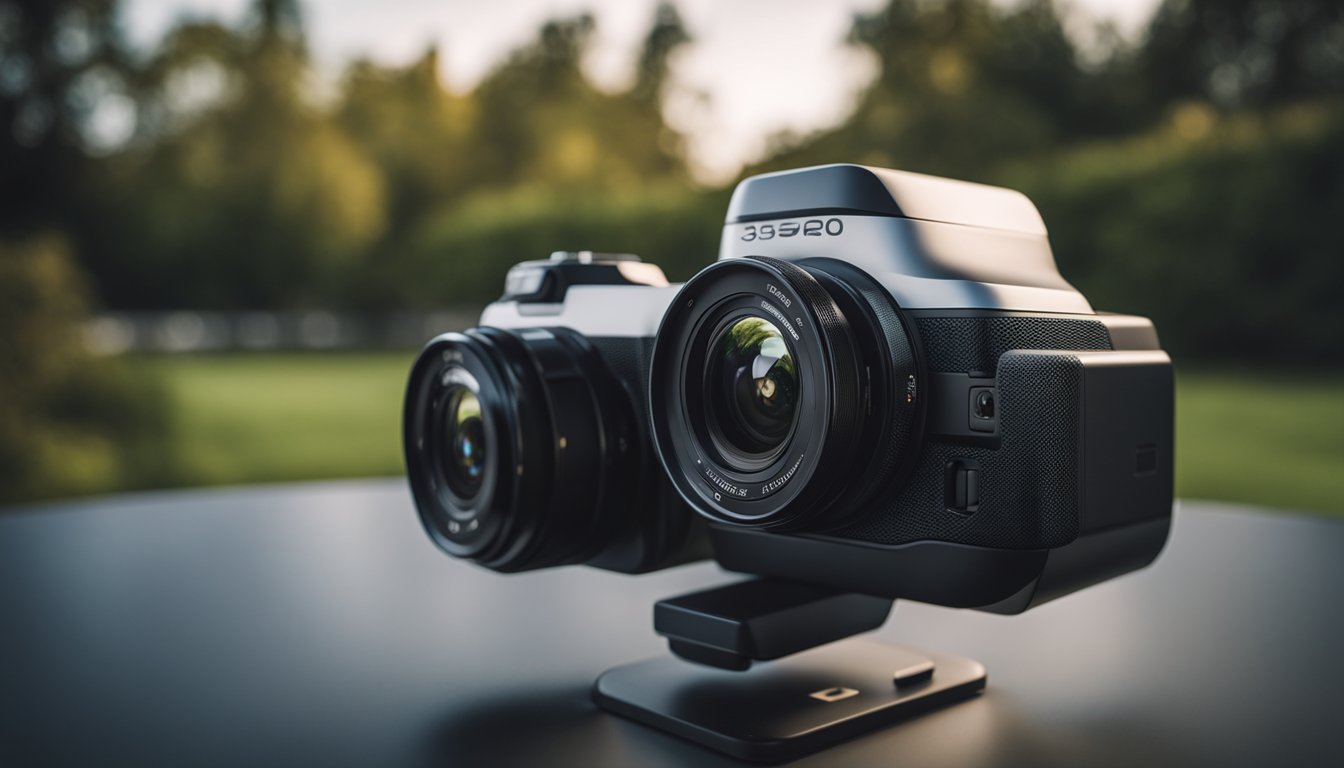
When it comes to choosing between a 360 camera and a reverse camera, durability and design are important factors to consider. Here are some considerations to help you make an informed decision.
Weatherproofing and Ruggedness
If you plan to use your camera in harsh weather conditions, it’s important to choose a camera that is weatherproof and rugged. A 360 camera with weatherproofing will be able to withstand rain, snow, and other harsh conditions without getting damaged. Some 360 cameras are designed to be rugged and shockproof, which means they can withstand accidental drops and bumps.
On the other hand, a reverse camera may not be as weatherproof or rugged as a 360 camera. While some reverse cameras are designed to be weatherproof, they may not be able to withstand harsh weather conditions or accidental drops.
Modular and Compact Designs
360 cameras are often designed to be modular and compact, which makes them easy to use and carry around. Some 360 cameras are designed to be mounted on a helmet or a tripod, while others can be attached to a smartphone or a tablet. This makes them ideal for outdoor activities such as hiking, camping, and biking.
Reverse cameras, on the other hand, may not be as modular or compact as 360 cameras. They are often designed to be mounted on the rear of a vehicle, which means they may not be as versatile as 360 cameras.
In conclusion, when it comes to durability and design, 360 cameras have an advantage over reverse cameras. They are often weatherproof, rugged, modular, and compact, which makes them ideal for outdoor activities.
Camera Connectivity and Accessories
https://www.youtube.com/watch?v=0uGvsRNp0LM&embed=true
When it comes to connectivity and accessories, both 360 cameras and reverse cameras have their own unique features. Here are some things to consider:
Compatibility with Other Devices
Most 360 cameras and reverse cameras connect to your mobile device via Bluetooth or Wi-Fi. This allows you to view and control the camera from your phone. However, some cameras may only be compatible with certain devices, so make sure to check before purchasing.
If you plan on using your 360 camera for VR purposes, you will need a VR headset that is compatible with your phone. Some popular VR headsets include the Samsung Gear VR and Google Cardboard.
On the other hand, reverse cameras are usually connected to your car’s infotainment system. This means that you can view the camera feed directly on your car’s display. However, not all cars have built-in infotainment systems, so you may need to purchase a separate display screen.
Additional Equipment
Both 360 cameras and reverse cameras may require additional equipment depending on your needs. For example, if you plan on using your 360 camera for action sports, you may need a waterproof case or a stabilizer. Some popular accessories for 360 cameras include tripods, selfie sticks, and external microphones.
For reverse cameras, you may need to purchase additional wiring or adapters depending on your car’s make and model. Some reverse cameras also come with parking sensors or guidelines to help you park more accurately.
Software
Both 360 cameras and reverse cameras may come with their own software for editing and viewing footage. Make sure to check if the software is compatible with your device and if it has the features you need. Some popular software for 360 cameras include GoPro Fusion Studio and Insta360 Studio. For reverse cameras, some popular software includes iDatalink Maestro and Pioneer AVH-4201NEX.
Overall, both 360 cameras and reverse cameras have their own unique connectivity and accessory features. Make sure to consider your needs before purchasing to ensure that you get the right camera for you.
Applications and Use Cases
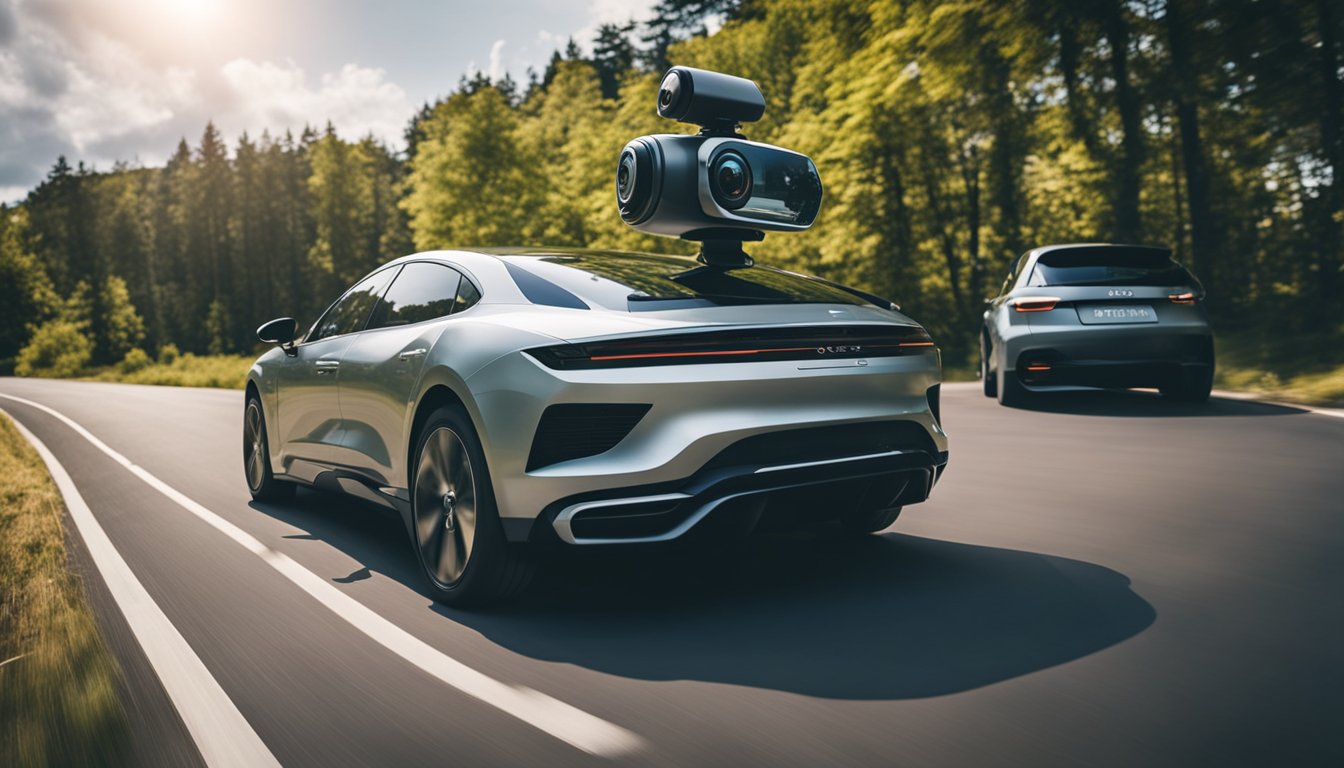
Professional vs. Personal Use
When it comes to 360 cameras vs. reverse cameras, there are a number of different applications and use cases to consider. One of the most significant differences between the two is that 360 cameras are typically used for professional applications, while reverse cameras are generally used for personal use.
For example, if you’re a real estate agent, you might use a 360 camera to create virtual tours of properties that you’re trying to sell. This can be a great way to give potential buyers a better sense of what a property looks like before they schedule an in-person visit. Similarly, if you’re a filmmaker or vlogger, you might use a 360 camera to capture immersive footage that can be used in a variety of different ways.
On the other hand, reverse cameras are typically used in personal vehicles to help drivers back up and park more safely. They’re also commonly found in newer cars as a standard feature.
Specialized Applications
In addition to these more general use cases, there are also a number of specialized applications where 360 cameras or reverse cameras might be particularly useful.
For example, if you’re an action sports enthusiast, you might use a 360 camera to capture footage of your adventures from all angles. Similarly, if you’re a drone pilot, you might use a 360 camera to capture panoramic views of the landscape below.
Overall, both 360 cameras and reverse cameras have their own unique strengths and weaknesses. Depending on your specific needs and use cases, one may be a better fit for you than the other.
Notable Brands and Models
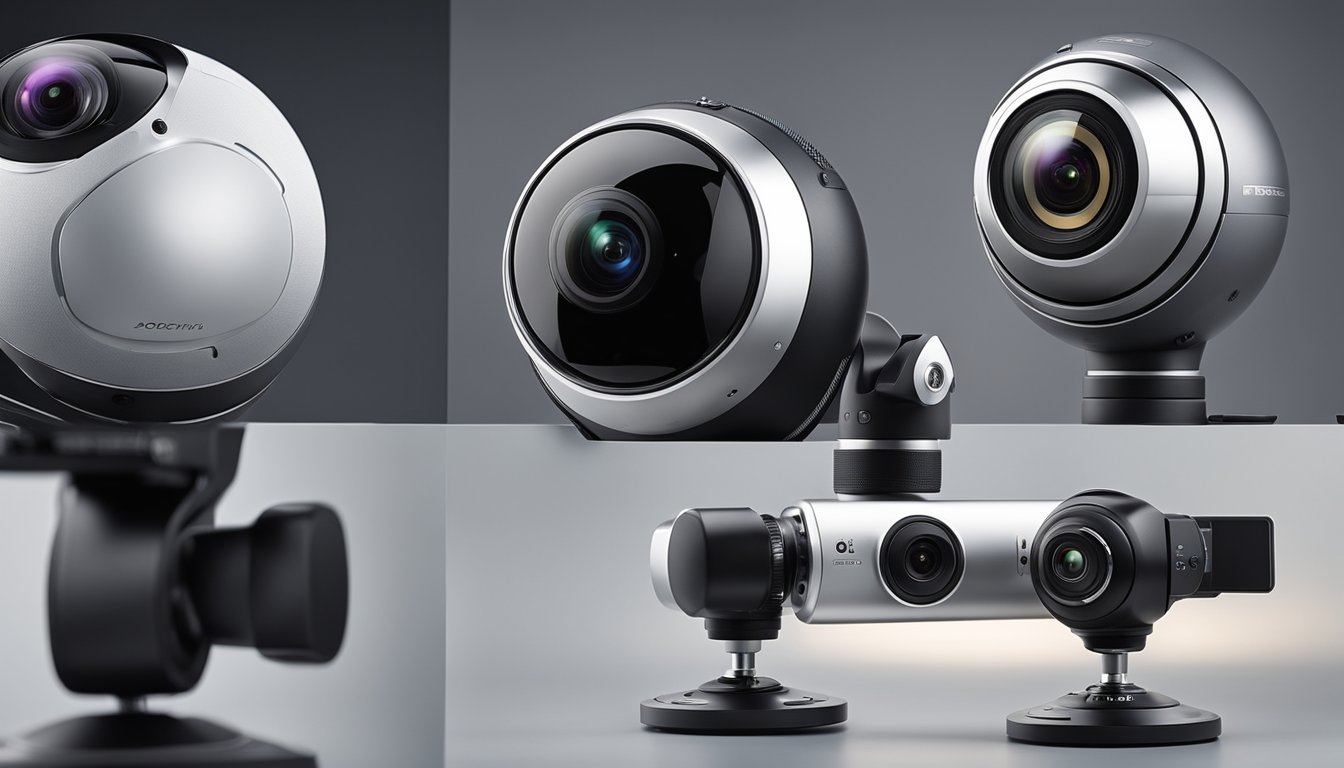
When it comes to 360 cameras, there are a few leading brands that stand out. One of the most popular brands is GoPro. Their MAX 360 camera is a top-of-the-line option that offers excellent image stabilization and a 360-degree view. Another popular option is the Insta360 One R, which has a modular design that allows you to swap out different camera modules depending on your needs. The One R also offers excellent image quality and stabilization.
Samsung is another well-known brand in the 360 camera market. Their Gear 360 (2017) camera is a popular choice among consumers. It offers 4K video recording and has a compact design that makes it easy to carry around.
On the other hand, when it comes to reverse cameras, many car manufacturers offer their own branded options. Audi, Ford, Kia, BMW, Mercedes-Benz, and Land Rover are just a few of the car manufacturers that offer reverse camera systems as standard or optional equipment.
If you’re looking for an aftermarket reverse camera, there are a few popular options to consider. The Nissan RearView Monitor is a popular choice among Nissan owners, while the Chevrolet Infotainment 3 system offers a high-quality reverse camera option for Chevy drivers. The Lexus Enform system and the Mercedes-Benz COMAND system are also popular options among luxury car owners.
Overall, whether you’re looking for a 360 camera or a reverse camera, there are plenty of options to choose from. Consider your needs and budget, and do your research to find the best option for you.
Advanced Features and Innovations
https://www.youtube.com/watch?v=BGG-ux-sZJo&embed=true
Cutting-Edge Technology
360 cameras have come a long way since they were first introduced. Today’s 360 cameras are packed with advanced features and cutting-edge technology that make them a must-have for anyone looking to capture immersive footage. One of the most impressive features of modern 360 cameras is their ability to capture 8K footage. This ultra-high-resolution footage is incredibly detailed and provides an immersive viewing experience that is hard to match.
Another feature that sets 360 cameras apart from traditional reverse cameras is their ability to capture 3D footage. This adds a whole new level of depth to your videos and makes them even more immersive. With a 360 camera, you can capture not just what is in front of you, but also what is above and below you, giving viewers a truly unique perspective.
Future Outlook
As technology continues to evolve, so too do 360 cameras. The future looks bright for this innovative technology, with new features and advancements on the horizon. One area where 360 cameras are poised to make a big impact is in the world of virtual reality. With their ability to capture immersive 3D footage, 360 cameras are the perfect tool for creating VR experiences.
Another area where 360 cameras are likely to see continued innovation is in their ability to capture overhead views. This is particularly useful for capturing footage of large crowds or events, as it allows you to see everything from a bird’s eye view. As technology continues to improve, we can expect to see even more advanced features and innovations from 360 cameras in the years to come.
Overall, 360 cameras are an incredibly powerful tool for capturing immersive, high-quality footage. With their advanced features and cutting-edge technology, they are sure to be a valuable addition to any videographer’s toolkit.
Frequently Asked Questions
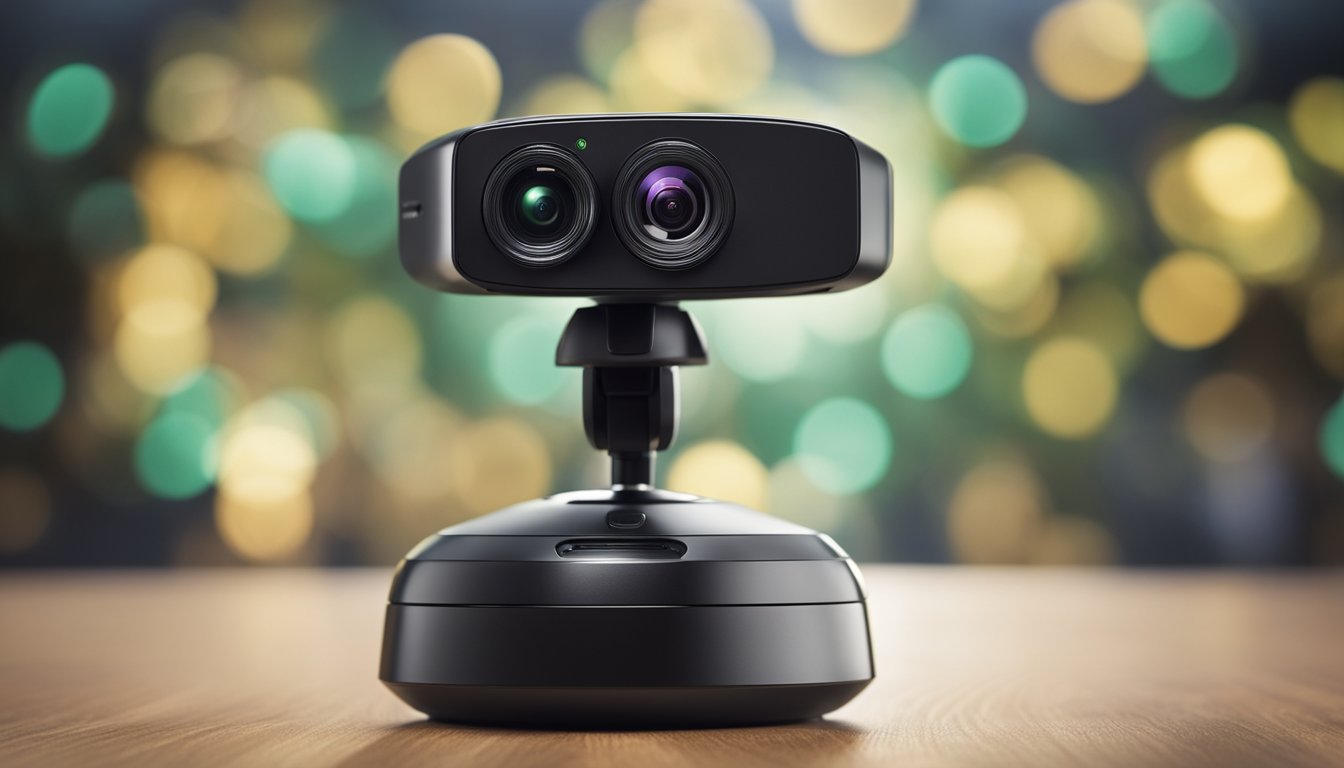
What are the benefits of having a 360-degree camera in a car?
A 360-degree camera provides a comprehensive view of your surroundings, which can be very helpful when parking or maneuvering in tight spaces. With a 360-degree camera, you can see all around your car, including the areas that are not visible in the rearview or side mirrors. This can help you avoid collisions with other vehicles, objects, or pedestrians.
How does a 360-degree camera system enhance parking compared to a traditional reverse camera?
A 360-degree camera system provides a bird’s eye view of your car, which makes it easier to park in tight spaces. With a 360-degree camera, you can see the entire area around your car, including any obstacles that may be in your path. This can help you park more accurately and avoid hitting other cars, curbs, or objects. In contrast, a traditional reverse camera only shows the area behind your car, which may not be sufficient for parking in tight spaces.
What are some cost-effective vehicle options that come with a 360-degree camera?
Many modern cars come equipped with 360-degree camera systems as standard or optional features. Some cost-effective options include the 2023 Honda Civic, the 2023 Toyota Camry, and the 2023 Mazda CX-5. These vehicles offer 360-degree camera systems that provide a comprehensive view of your surroundings.
Can a 360-degree camera system be useful for car racing events?
Yes, a 360-degree camera system can be useful for car racing events. With a 360-degree camera, you can see all around your car, which can help you navigate tight turns and avoid collisions with other cars. Additionally, some 360-degree camera systems offer features such as lap timing and telemetry data, which can be helpful for analyzing your performance on the track.
What are the common drawbacks of using a 360-degree camera in vehicles?
One of the common drawbacks of using a 360-degree camera system is that it may be distracting to some drivers. With so much information on the screen, it can be difficult to focus on the road ahead. Additionally, some 360-degree camera systems may not provide a clear picture in low-light conditions or during inclement weather.
Which SUV models in 2023 offer the best 360-degree camera systems?
Some of the best SUV models in 2023 that offer 360-degree camera systems include the 2023 BMW X5, the 2023 Audi Q8, and the 2023 Mercedes-Benz GLE-Class. These vehicles offer advanced camera systems that provide a comprehensive view of your surroundings, making it easier to park and maneuver in tight spaces.

